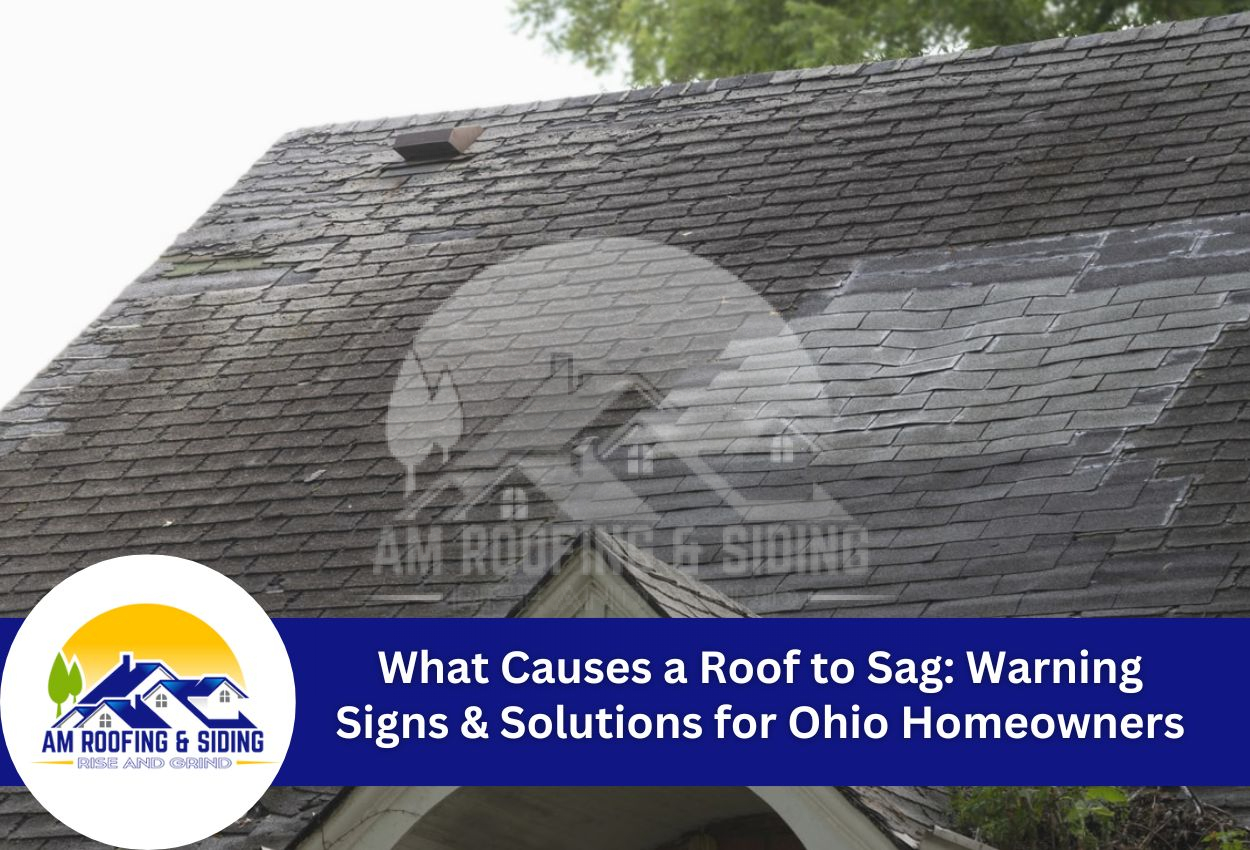A sagging roof is more than just an aesthetic concern, it’s a warning sign that your home’s structural integrity may be at risk. For Central Ohio homeowners, understanding what causes a roof to sag is essential for maintaining your property and avoiding extensive damage. Whether you’ve noticed a slight dip in your roofline or are being proactive about roof maintenance, identifying the underlying issues is the first step toward effective solutions.
Roof sagging typically develops gradually over time, often starting with subtle signs that can easily go unnoticed. These may include visible dips or waves along the roofline, doors that suddenly stick, or cracks appearing in interior walls. The causes range from water damage and excessive weight to structural weaknesses and age-related deterioration. Each factor results in different roof structural damage signs that require specific attention.
Early detection of these problems is crucial. What might begin as a slight depression can quickly escalate into a structural issue requiring expensive repairs or even complete roof replacement. Ohio’s variable climate, with heavy snow in winter and intense storms in summer, can accelerate roof sagging problems. Recognizing these causes allows homeowners to identify warning signs early and take steps to stop minor issues from becoming major headaches.
Excessive Weight: How Snow, Ice, and Debris Affect Your Roof
Ohio’s seasonal weather can stress residential roofing systems. Heavy snow and ice accumulation during harsh winters can place extraordinary weight on your roof’s structure. Wet snow can weigh approximately 20 pounds per square foot, adding thousands of pounds of pressure to your roofing system. When this weight exceeds your roof’s load-bearing capacity, sagging becomes inevitable.
Beyond winter weather concerns, improper debris management significantly contributes to roof sagging throughout the year. Fallen leaves, branches, and other organic matter collect in valleys and gutters, trapping moisture against your roofing materials. This trapped moisture not only adds weight but also accelerates the deterioration of structural components. In shaded areas, moss and algae growth compound these issues by retaining additional moisture and creating persistent dampness that weakens roof decking.
Regular roof maintenance is crucial to prevent weight-related sagging. Central Ohio homeowners should schedule professional roof inspections after major snowstorms and during fall to remove accumulated debris before winter. Professional roofers can safely clear snow buildup, clean gutters, and identify early signs of stress before they lead to visible sagging. They can also recommend appropriate solutions for your specific roof type and condition, potentially saving thousands in future repair costs.
Structural Failure: Identifying Compromised Support Systems
The backbone of every reliable roof is its support structure. When these critical components begin to fail, the result is often a visibly sagging roofline. In many Central Ohio homes, specifically older properties, inadequate roof framing is a common culprit. Undersized rafters that may have met building codes decades ago are often insufficient for supporting modern roofing materials. Similarly, improperly installed trusses can begin to bend or break under the constant pressure of supporting your roof’s weight.
Foundation issues frequently contribute to roof structural problems in ways many homeowners don’t immediately recognize. As Ohio’s clay-rich soil expands and contracts through seasonal freeze-thaw cycles, foundations may settle unevenly. This movement transfers stress upward through the entire house structure, eventually reaching the roof. The result is walls that no longer support roof elements, creating visible dips along the roofline.
Warning signs of these structural failures include cracked interior walls, doors that no longer close properly, and visible bowing of exterior walls. If you notice roof sagging combined with these symptoms, your home likely needs a comprehensive structural evaluation. Professional roofers can identify whether the sagging stems from roof-specific issues or is a more systemic structural problem. Addressing these structural concerns promptly prevents roof sagging from progressing to catastrophic failure that endangers your family and property.
Water Damage: The Silent Destroyer of Roof Integrity
Water leaks are one of the most destructive forces when it comes to Central Ohio homes. Persistent leaks, even minor ones, initiate a cycle of deterioration that can ultimately lead to significant roof sagging. When water penetrates your roofing system, it targets wooden components like rafters, trusses, and decking. These materials absorb moisture, weaken, and gradually lose their structural integrity. Over time, what begins as simple water staining evolves into dangerous rot that compromises your roof’s ability to maintain its shape.
Poor attic ventilation compounds water damage problems, particularly in older Ohio homes. When warm, moist air from lower levels of your home rises into the attic but cannot escape, it creates condensation. This trapped moisture settles on roof components, causing them to deteriorate from within, often undetected until sagging becomes visible. The problem worsens during Central Ohio winters when temperature differentials between heated interiors and cold attics are most extreme.
Preventing water-related roof sagging requires vigilance. Regular inspections can identify early signs of moisture intrusion before structural damage occurs. Attic ventilation systems are essential for controlling humidity levels and preventing condensation buildup. For homes already showing signs of water damage, fixing sagging rooflines typically involves addressing both the source of water intrusion and repairing or replacing compromised structural elements. Professional roofing contractors can evaluate the extent of water damage and recommend appropriate repair strategies.
Age-Related Deterioration: Understanding Your Roof’s Lifespan
Even the best-constructed roofs eventually succumb to the natural aging process. Different roofing materials common in Ohio homes have varying lifespans. For example, asphalt shingles usually last 20 to 30 years, and metal roofs for 40 to 70 years. As these materials age, they become more susceptible to damage and less capable of protecting the structural elements beneath them. Aging roof decking loses strength and flexibility, while rafters and trusses may develop subtle weaknesses after decades of supporting your home.
Central Ohio’s climate may accelerate this aging process. The region’s freeze-thaw cycles put extraordinary stress on roofing materials as they repeatedly expand and contract. Summer heat waves followed by harsh winters cause gradual material fatigue that compounds over decades. UV radiation breaks down roofing components at the molecular level, while fluctuating humidity levels cause wooden structural elements to repeatedly swell and shrink, weakening their integrity over time.
Understanding your roof’s age is crucial for preventing sagging. Regular professional inspections become increasingly important as your roof approaches the end of its expected lifespan. Many homeowners mistakenly wait until visible sagging appears before addressing age-related deterioration. By implementing preventative maintenance and planning ahead for a roof replacement, you can avoid the structural damage that leads to expensive repairs and protect your home for years to come.
Prevention Strategies: Protecting Your Roof from Sagging
Preventing roof sagging is significantly more cost-effective than repairing structural damage after it occurs. Central Ohio homeowners can follow several proactive strategies to extend roof lifespan and maintain structural integrity despite our region’s challenging weather conditions. A comprehensive prevention plan includes regular professional inspections, maintenance, and addressing damage as soon as it’s discovered.
Seasonal maintenance should follow a consistent schedule tailored to our local climate. Spring inspections should focus on identifying winter damage from snow and ice, while fall maintenance should prepare your roof for upcoming cold-weather stresses. Professional roofers can spot early warning signs of potential sagging, including minor deck deflection, shingle distortion, or subtle changes to your roofline. They can also safely clean gutters and remove debris that traps moisture against roofing components.
Attic insulation and ventilation play crucial roles in preventing roof sagging throughout Ohio’s seasonal temperature shifts. Adequate insulation prevents heat transfer that accelerates shingle deterioration and reduces the likelihood of ice dams during winter. Meanwhile, effective ventilation systems remove excess moisture that would otherwise weaken structural wood components. Together, these systems maintain consistent temperatures across your roof surface, minimizing expansion and contraction stress that contributes to premature aging and eventual sagging.
Professional Solutions: When and How to Address a Sagging Roof
Determining when to call in professional help for a sagging roof requires careful assessment of the problem’s severity. Minor cosmetic sagging might be manageable with DIY reinforcement, but structural issues require expert intervention. If your roof shows significant depression, visible rotting of support beams, or if the sagging has worsened rapidly, these are clear indicators that professional roofing contractors should evaluate the situation immediately. Ohio homeowners should also seek professional help if the sagging appears after severe weather or if interior walls show cracks near ceiling joints.
Professional roofers offer various restoration options depending on the underlying cause and extent of damage. For localized sagging caused by weakened rafters, supplemental supports or sister rafters may provide adequate reinforcement. More extensive damage might require partial restructuring of the roof framework. In cases where water damage has compromised large sections of the roof deck, professionals might recommend partial or complete roof replacement to ensure long-term structural integrity.
Addressing a sagging roof promptly with professional help ultimately saves money and prevents further complications. Central Ohio roofing specialists can identify hidden damage that untrained eyes might miss and implement solutions that meet local building codes. They can also recommend appropriate preventative measures to protect your newly restored roof from future sagging problems.
Expert Roof Repair and Restoration in Ohio
If your home shows signs of roof sagging, don’t wait. Addressing roof sag issues promptly can save you from extensive damage in the future. AM Roofing & Siding offers complete residential roofing services, including diagnosing and repairing sagging roofs, so your home remains safe and secure. Whether it’s due to excessive weight, structural failure, water damage, or age-related deterioration, our team has the expertise to provide effective solutions tailored to your needs.
Don’t let a sagging roof threaten the safety of your home. Call AM Roofing & Siding today at (740) 974-8268 to schedule a professional assessment and discuss your repair options.

